Venetian plaster – a type of interior decoration, which was successfully used during the times of Michelangelo and Leonardo da Vinci. The walls and ceilings of temples and palaces were covered with a mixture of lime and crumb of marble, granite and other rocks with natural dyes, and painted on the raw material – the famous Renaissance frescoes. The current “Venetian”, as professionals call it, differs significantly from the original source in its composition, abundance of textures and colors, but this does not prevent it from being used to create uniquely beautiful interiors in homes, apartments, offices, theaters and other public places.

Features decorative coating
The method of laying Venetian plaster is laborious and requires professionalism and experience, but the result is definitely worth the time and money. The covering is suitable for finishing of walls, ceilings, arches, window and doorways, niches, columns. By choosing the appropriate type and tinting, you can create a surface that imitates Carrara marble, concrete, material that seems to glow from the inside or an exclusive hand-painted panel. Venetian plaster in the interior of the apartment is combined with other types of decoration, fits into the premises of different styles and purposes. An example of the use of Venetian plaster in the design of the apartment – in the photo.
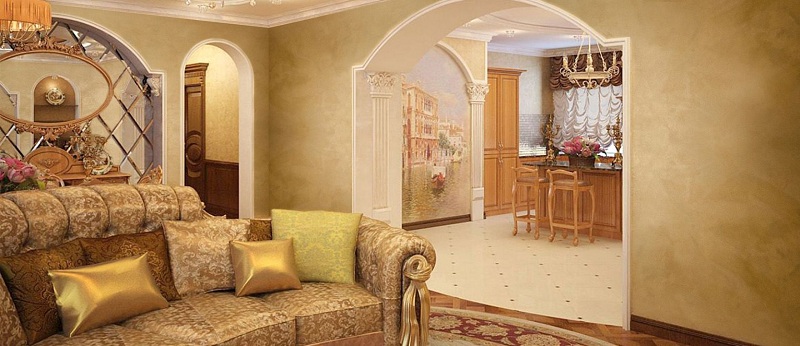
Components of Venetian plaster
The structure of the Venetian plaster includes:
- a small fraction of natural stones (marble, granite, onyx, malachite, limestone and other rocks);
- binding material (silicates, acrylic resins, silicone, cement);
- pigment dyes (mostly artificial).
The larger the stone crumb in the composition of the plaster, the better the coating is obtained, fine dust is not the best option. Mixtures with acrylic components are elastic but are exposed to UV rays, so they are best applied on the surface in the shade. Cement gives the finish high durability and light shade, and silicone-based plaster can even be used for facade work, which is hampered by the high cost of finishing. Silicate blends give the Venetian an increased strength and resistance to moisture; they are recommended to be used in the interior of kitchens and bathrooms.
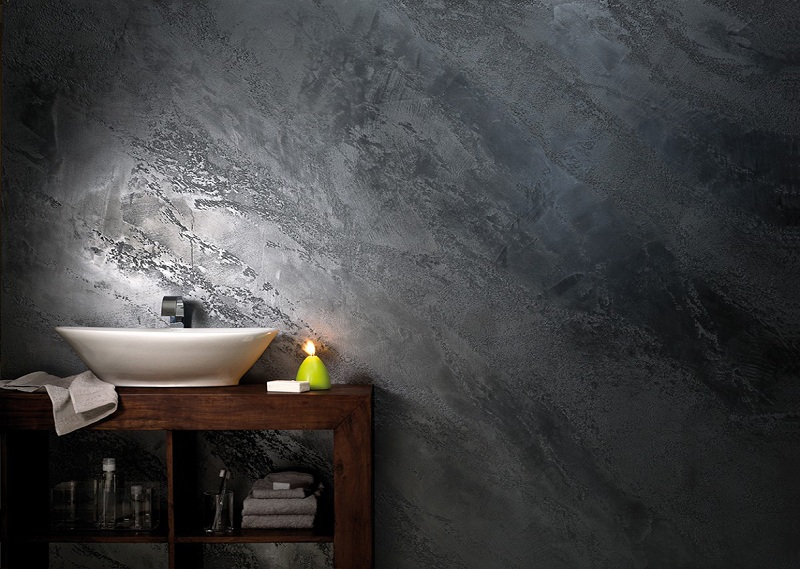
Advantages and disadvantages
The advantages of stone chips include:
- ecological purity, hypoallergenicity, harmless to people and animals;
- resistance to moisture;
- the minimum term of operation is 15 years;
- simple care (cleaning with soapy water);
- applied to any surface (brick, drywall, wood, chipboard, concrete), except metal;
- resistance to fire;
- beauty, the variety of textures and shades;
- the ability to disguise minor irregularities;
- paint and wallpaper can be applied over the plaster.
Disadvantages of coverage:
- the high cost of material and finishing works requiring high professionalism;
- application complexity (preparation, obligatory leveling of the walls, from 3 to 12 layers of coating, manual grinding, finishing).
If we are talking about finishing the apartment in a new house, you need to let it “stand” for a couple of months, otherwise, in case of precipitation of the walls, the coating may cause cracks.

Types of coatings and their differences
Types of Venetian plaster differ not only in color, composition and application options but also in texture, as well as other important characteristics. The most famous types include:
- Trevignano (Trevignano). Transparent layers of different shades create the effect of a luminous coating, have a smooth mirror surface, perfectly harmonize with frescoes, interiors in rococo, baroque style, vintage, and classical design.
- Veneto (Veneto). This type of “Venetian” looks like brushed polished marble, is easy to apply, suitable for all types of an interior from rustic to minimalism.
- Marbella (Martello) resembles a roughly hewn marble, different matte, rough, velvety surface, and many small veins. Suitable for rooms with high humidity – kitchens, bathrooms, showers.
- Imperiale imitates marble with a golden hue. The translucent surface with tonnes of different depths flickers with golden highlights due to the addition of a special pigment.
- Encaustic (Encausto) imitates matte granite of different shades. Requires mandatory waxing for better moisture resistance and durability.
- Tierrafino (Tierrafino) creates the effect of a multi-layer nacre coating, which, as if illuminated from the inside, resembles gilded marble or travertine.
To give the plaster various effects, manufacturers add golden pigments, mother-of-pearl, and wax (this coating is called “Marseille wax”). Looks impressive cracker plaster with a cracked surface. Masters put whole pictures directly on the plaster – patterns, mythological plots, landscapes.
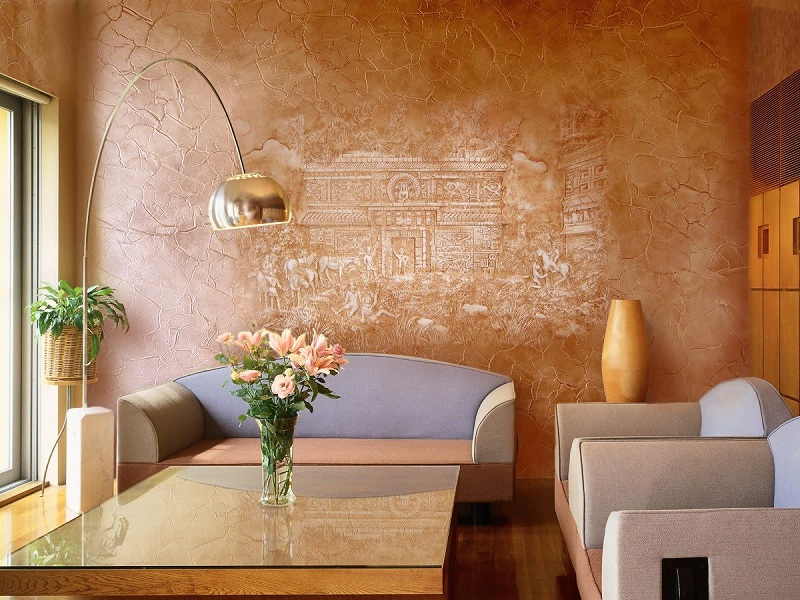
Initially, the dyes for Venetian plaster gave it a resemblance to marble (imitation of Carrara marble, which is no longer mined in its natural form), is especially appreciated, and natural white, milky, pink, beige, and silver shades prevailed in their palette. However, not every apartment will be decorated with an imitation of natural stone, be it granite, malachite or marble. In a modern interior, a gray concrete or black wall surface will look much more organic, while a beautiful blue, burgundy, emerald, blue, purple, chocolate plaster will be the main focus of a bedroom, kitchen or bathroom (the inspirational examples are in the photo).

Venetian plaster in the interior of rooms of different styles
Stone-based plaster is easy to combine with other types of coatings: wood, concrete, glass, wallpaper, photo wallpapers, brick, and mirror surfaces. Imitating natural stone or velvet upholstery “Venetian” is combined with the design of rooms in the Empire style, Baroque, Rococo. Rough surfaces are appropriate in rooms designed in the castle, gothic, Mediterranean style. The glossy and mirror coating of the walls will decorate the apartments in the style of Art Deco, modern, and the stucco styled as granite or concrete will have to be placed in a minimalist, avant-garde interiors, futurism, loft, and high-tech.

Where does appropriate Venetian plaster finish?
Due to the variety of textures and shades, the Venetian can be used in any room. It is recommended to apply bright coatings fragmentarily, especially in rooms intended for rest, making accent one wall, niche or headboard. Stone walls, even if they are imitations of natural rock, are a very controversial solution for small apartments, so the choice of color, texture, and area of coverage should be approached very carefully, using as much as possible using it and maintaining it with other materials, colored textiles, and furniture of a certain style. .
Hall, living room, dining room
Living room or dining room – just the place in the apartment, which is ideal for vivid experiments. A large and well-lit room will be decorated with rich tones. For a classic living room is ideal cream, ocher, pastel, bluish-gray or gently emerald plaster. In combination with chandeliers, stucco, moldings and high snow-white plinths, natural curtains such shades will make the room elegant and expressive. There will be appropriate paintings and frescoes, sideboards with transparent doors and large mirrors.
Gray and pink, powdery, light-green colors will add comfort and spaciousness to small rooms in any style, and dark and rich shades of emerald, ultraviolet, wine colors will emphasize the elegance of the rooms in the spirit of art deco, modern, eclectic.

Hallway, corridor
Venetian plaster in the hallway and corridor – a practical and stylish solution. It makes a certain charm even in the most simple and minimalist interior, durable and easy to maintain. Stone chips perfectly combine with a mirror wall or a built-in wardrobe, ceramic tiles or porcelain stoneware on the floor, creating a feeling of harmonious space. In a narrow corridor, murals in the entire wall would be appropriate, distracting attention from the small size of the room, and a properly organized lighting will turn such a hall into a real work of art.
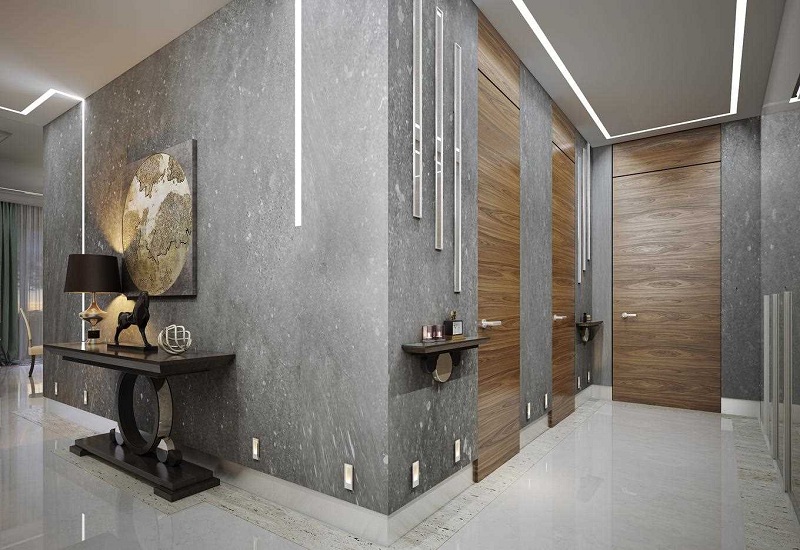
Bedroom, children
In the bedroom and children’s room it is recommended to use delicate, pastel or saturated, but soft shades with small patches. Coziness and peace will bring types of Venetian plaster with a velvety texture imitating the decoration of soft fabrics. Any coating must be combined with furniture, textiles, lamps, insulation level of the room. Light and neutral finishes are suitable for most rooms, except for the beautiful accent wall at the head of the bed or in the play corner in the children’s room. An example of a successful design – in the photo.
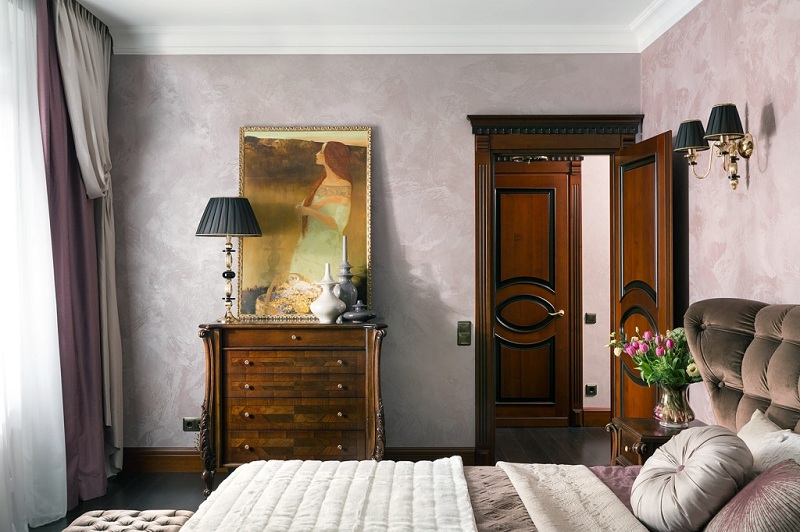
Bathroom
In the bathroom most often used plaster decoration for pink, white, Carrara marble with deep veins. In combination with snow-white tile, high plinths, lamps, such a coating will turn an ordinary bathroom into a corner of the Roman bath and significantly add to the volume of even a tiny bathroom. Alternative options (rich blue, turquoise, blue) in the decoration of the walls echo the style of the sea, evoke a feeling of coolness. Modern interiors require non-standard solutions. Even a small bathroom is finished with black, dark gray plaster, a coating imitating concrete, obsidian, granite in combination with the latest generation of sanitary ware (stone sinks, weightless, transparent showers, installations,

Examples of the design of plaster bathrooms and other rooms in a regular apartment deserve admiration, as is easy to see when looking at photos from our selection. Get inspired and make your dreams come true!

